Growing mango at home

Mango is one of the more popular tropical fruits. Delicious, sweet and healthy, it is widely demanded in baby and adult nutrition. However, it should be noted that mango fruits are not cheap at all, and it is not always easy to find a quality product in supermarkets. Therefore, many gardeners and ordinary residents of apartments try to grow mangoes on their own. It is quite possible if you make an effort.
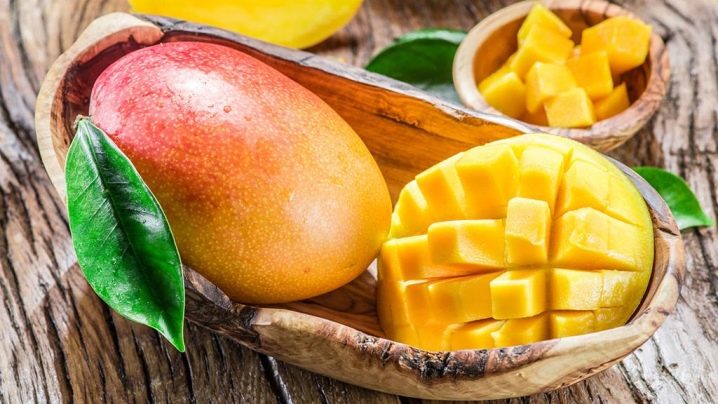
Description of the tree
The homemade mango tree looks quite peculiar. It has a relatively low height, about 1.5-2 meters, and feels good in a large flowerpot. Has a developed root system. The foliage of young trees is usually yellowish or pink, sometimes specimens with a red tint are found. Mature trees have dark green leaves.
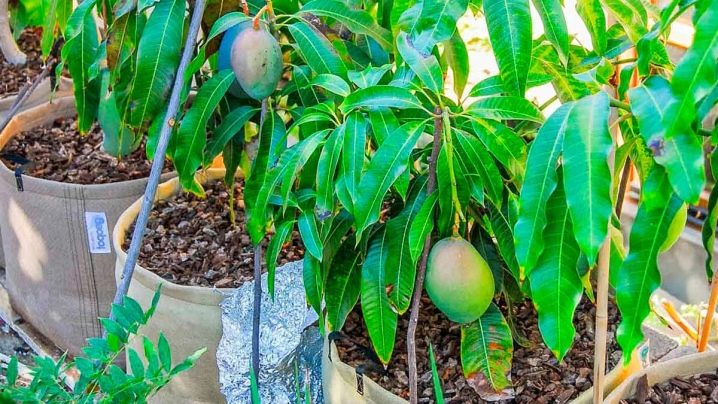
I must say that at first, the sheet plates do not differ in effectiveness. On the contrary, they look lifeless. The local population that grows mangoes in their natural conditions even calls them "scarves", hinting that they look like drying linen, which flutters the wind. Then the foliage hardens, becomes more interesting in appearance, decorative, begins to shine beautifully.
The leaves are extremely poisonous, so growing mangoes in apartments with animals or small children is strongly discouraged.
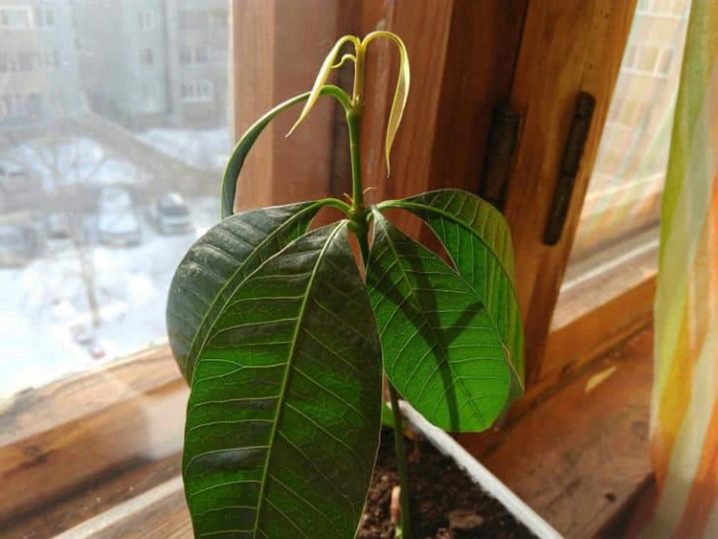
The mango tree blooms in the spring, at the very beginning, sometimes the flowering dates are at the end of February. The flowering is plentiful, this process looks amazing, since one inflorescence can have up to ten hundred flowers. Their color is different: it can be yellow, pale pink or pale red. They resemble panicle inflorescences, differ in length - about 0.4 meters. The scent of flowers is similar to lily.
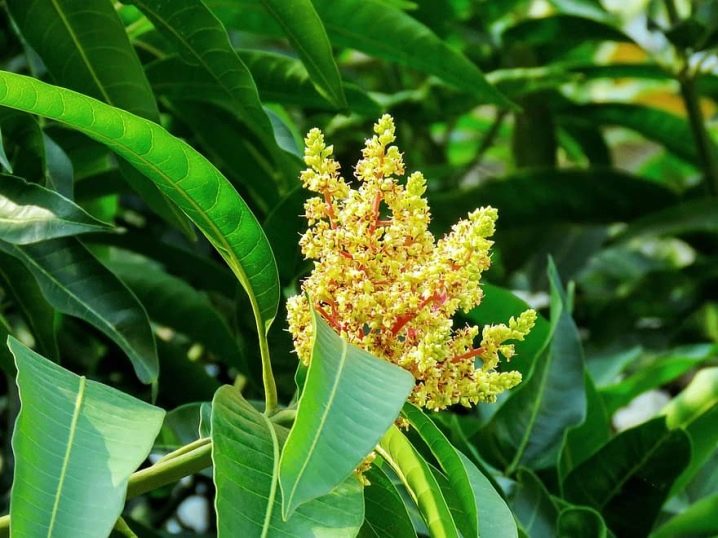
How does it grow in nature?
In its natural setting, the mango is fundamentally different from the humble home tree.... In nature, this is a real giant 40 meters high and with a crown diameter of 15 meters. The roots penetrate deeply into the soil, dropping by about ten meters and fixing there for many years. Natural mango begins to bear fruit very late - at 10-15 years old, homemade mango much earlier, subject to vaccination. The foliage and flowering are the same as at home, the taste of the fruit is also no different. A tropical tree lives for a very long time, about 300 years, and bears fruit until the end of its life.
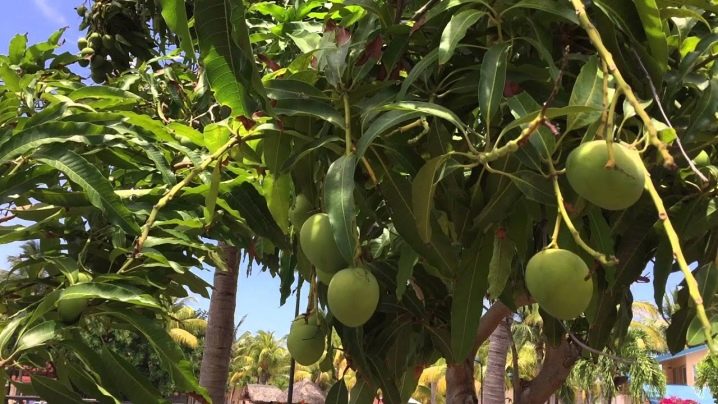
Views
You can list the types and varieties of mango endlessly, because there are very, very many of them, and breeders annually bring out new ones. According to some reports, today there are about 300 varieties, while other sources speak of as many as 1000. The types of mangoes are classified quite simply, since their names correspond to the territory in which they grow. Let's highlight several of the most popular species and their varieties.
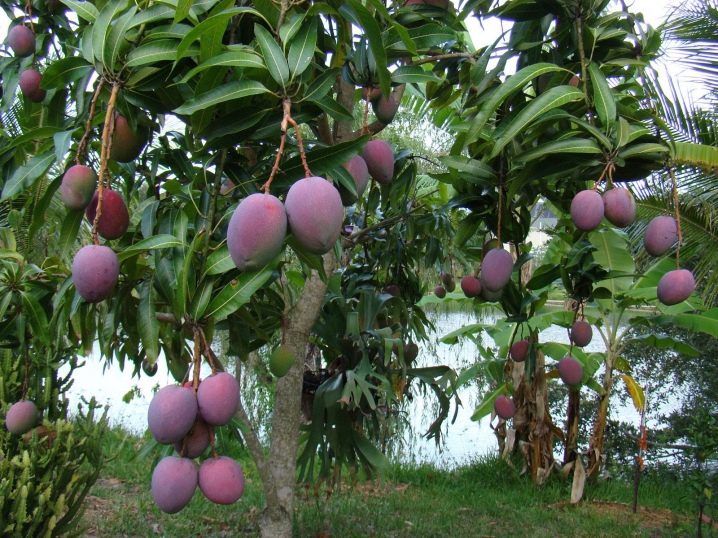
Thai
Mangoes from Thailand are high in sugar. In unripe fruits, a slight sourness is felt.
- Kaen Oan. The cultivar produces long yellow-orange fruits with a pink blush. They have a peach taste. They weigh about 0.2 kg and grow densely, so harvesting is very easy.
-
Pimsean... Deliciously sweet mangoes, but they are often overlooked by customers due to their green skin, which is considered unripe. However, it is not. The fruit also has a beautiful pink tint. They weigh 300-400 grams.
-
Gaew Lek... These are small bright green fruits up to 200 grams in weight. Sweet, tasty, very healthy, harvested in summer.The pulp contains fibers and creamy notes.
-
Nam doc Mai. It is this variety that can most often be found on supermarket shelves, because it is the most popular in Thailand. The fruits are large, sweet, creamy, yellow. In this case, you should not be tempted by a low price, since this is an indicator that the fruit is overripe. This means that it is no longer so tasty.
-
Keo Sa Woei. These are very beautiful dark green mangoes with an orange core. They weigh approximately 300 grams. Very tasty, with mixed notes of melon and peach, as well as pine needles.
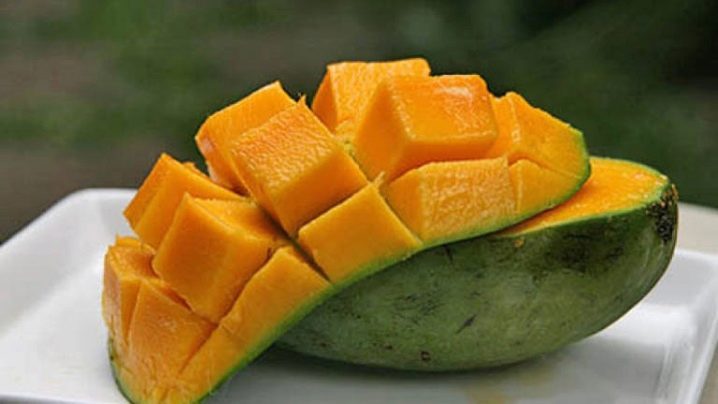
Balinese
Such mangoes are much less common, but they taste much better than the above type.
-
Chakanan... Small yellow mangoes with very delicate fiber-free flesh. The taste is sweet, with berry notes. The fruits are round in shape.
-
Mangga Gading. Yellow fruits of an elongated shape, unusual in taste, with sourness. An ideal solution for making desserts, juice.
-
Mangga kasam... This is one of the most delicious varieties in Bali. The skin is thin, yellow-orange, the fruit itself is sweet. Very easy to clean.
-
Wani... And this variety looks very unusual: it has a marsh or brown skin and white flesh. If eaten cold, it will look like a melon-flavored ice cream.
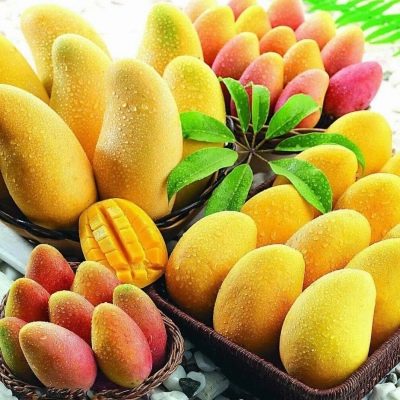
Indian
It was in India that mango cultivation was born. Therefore, every gourmet should try these varieties. Indian mangoes have delicate notes of berries and honey, and those who have already eaten them claim that they clearly felt the shades of black currant in the taste.
-
Alphonso... This variety is in demand all over the world. Medium-sized yellow mangoes are often found in stores, and the creamy flesh melts in your mouth. There are notes of saffron on the palate.
-
Kesar... The fruits are not very interesting to look at, as they are covered with spots. But they are sweet and sour and have one of the most recognizable aromas.
-
Dasheri... The large, light green fruits of the variety are especially prized in India, as one of the trees producing them is the oldest. The taste is honey, with a hint of pink pepper.
-
Chasua... These mangoes are large in size and have a bright yellow skin with a pinkish tint. The taste is very sweet, berry.
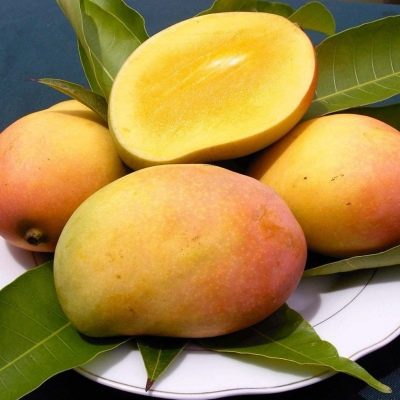
These are not all popular types and varieties of mangoes. There are also North and South American fruits obtained from trees with high immunity and winter hardiness, as well as Vietnamese and Brazilian mangoes. Delicious fruits of unique varieties can be obtained from:
-
Pakistan;
-
Cameroon;
-
Kenya;
-
Philippines.
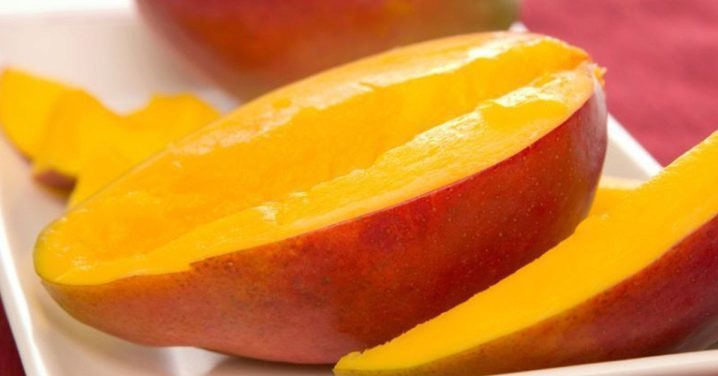
Germinating seeds at home
Despite the fact that now you can buy a mango seedling and plant it right away, many people prefer to go the more difficult path and sprout a seed. It is this growing method that will be described in the article.
Selection and preparation of seeds
The first step is to choose the right fruit. Decide on the variety that you like, and then proceed with the selection. Do not think that if a mango has a pink tint, then it is definitely ripe... The second misconception is that green fruits are not ripe, which is also not the case. There is no need to look at the color, only the consistency. Ripe mango (and only this will do) should be soft. Press down and a dent appears on it. You can and should take even overripe fruits.
It also happens that all the mangoes in the store are unripe. It's okay, take one and bring it home. And then place next to a couple of bananas. Soon the fruit is fully ripe.
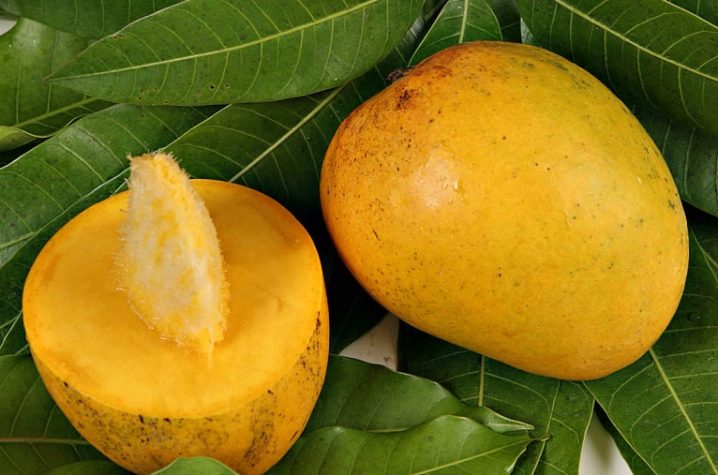
Next, you need to cut the mango and get the bone from there. It is useless to plant it, it will not germinate. There is a seed inside it, and you need it. In some cases, the shell of the bone is already cracked, in others it is not. If the shell does not open, pry it open with a knife the way you would open a clam. If it still doesn't work, put the bone in warm water for a week. After that, the shell should give way.
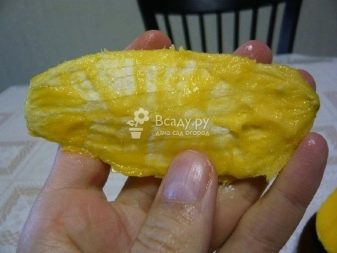
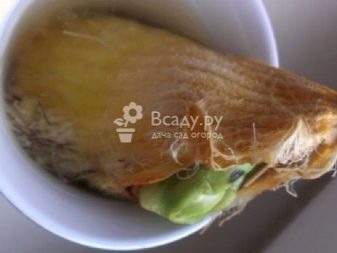
The extracted seed must be carefully washed with water and placed in a solution of manganese or any fungicide for 10 minutes. This will provide excellent protection against fungi. Then the seed is washed again.If you see a sprout, great, then you don't need to sprout. If not, the seed must be germinated. There are two options here.
-
Take a light breathable cloth (you can use gauze), wet it, and wrap the seed. The resulting blank is folded into a bag, and then into a plastic container with a lid. Closes and sits in a warm place without light. Every day, the container is opened, the fabric is moistened. In about 7-14 days, the grain will sprout. Then he can be planted.
-
Collect sawdust in a bowl, moisten them. Place the seed inside and place it in the dark and warm. Remember to control the moisture content of the substrate. Basically, the seed germinates after 21 days.
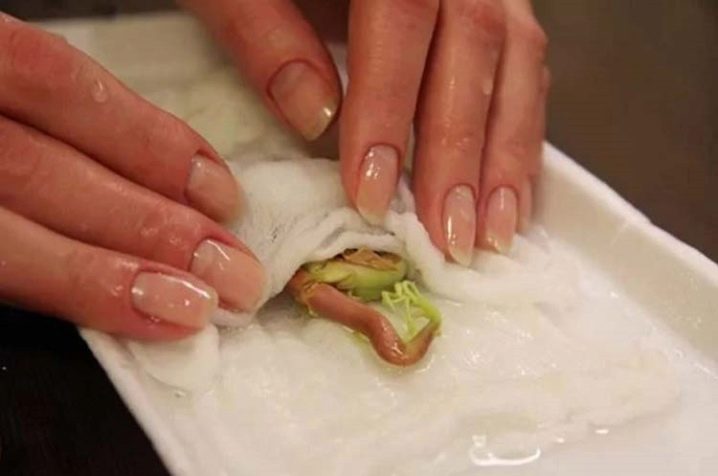
Soil and pot
While the grain is germinating, the correct soil and capacity should be arranged for it. Mango prefers loose soil with neutral acidity. A universal substrate, which is sold in any horticultural center, is quite suitable for him. If you want to prepare the land yourself, then use one of the following options:
-
peat (2 parts) and sand (1 part);
-
coconut soil (1 part), peat (1 part), perlite (1 part);
-
sod substrate and humus (1 part each), as well as 0.5 parts of sand.
Next, you must definitely check the acidity, since mango is demanding for this. The indicator should be between 6 and 7.
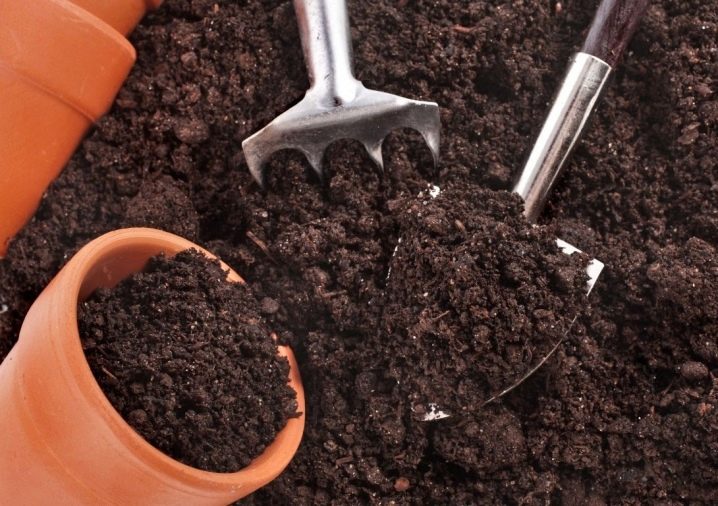
The first pot for the seedling should be small, about 10 centimeters in diameter. This is enough for the first time, then you will have to choose large containers with a thick bottom and from natural materials, since mango has strong roots and can easily damage the weak bottom of the pot with them. If there are no holes on the bottom, make them.
Landing
Planting mangoes is easy even for a beginner. Consider the stages of disembarkation step by step.
-
First of all, drainage is placed on the bottom of the pot. Its layer should be thick, occupying ¼ of the container volume.
-
Next, the pot is filled with a substrate, but not to the very top, but about 2/3... In the middle, make a hole 2 centimeters with your finger.
-
Put a seed in the hole with the root down, sprinkle with soil... About a quarter of the grain must remain on the surface, otherwise it will die.
-
Planting is sprayed from a spray bottle and covered with a shelter... It can be played by cans, bottles, glass, and film.
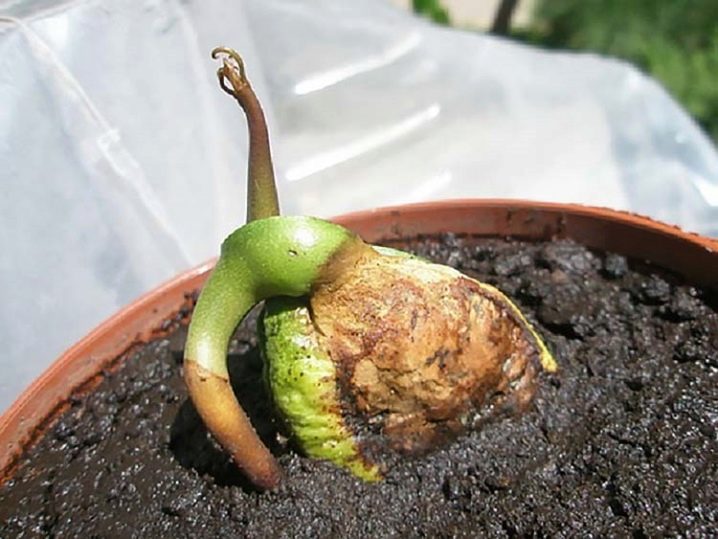
Correct conditions
In order for the mango to feel comfortable and develop correctly, it is necessary to provide it with the proper conditions. There are very few rules here. The room should be relatively warm. The normal temperature will be between 20 and 25 degrees, the humidity of the air at this stage does not matter, since the plant is closed. As for lighting, there should be plenty of it. If necessary, you have to use phytolamps. It must be said that direct rays are unacceptable for mangoes. Lighting should be soft, diffused, non-aggressive.
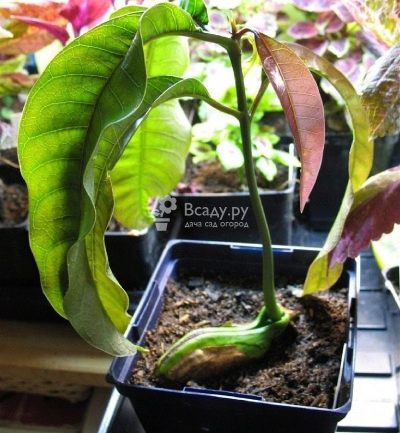
Further care of seedlings
After planting a seed in the ground, it will take about 2 weeks before a sprout appears. And before its appearance, and after it, the plant must be properly looked after. Let's look at the main stages of caring for a seedling.

Watering
Before the sprouts appear, the soil in the pot is moistened once every couple of days, while airing the greenhouse at the same time. When the sprout appears, the shelter is removed. The soil should always be slightly moist, but the plant cannot be poured, this is fraught with rotting of the root system and fungus. For watering, it is worth taking liquid at room temperature. Tap water is also suitable, which is important in the conditions of modern life, but it needs to be defended for a day or two. The seedling is irrigated carefully, at first from a spray bottle, then with the help of a small watering can.
Watering is carried out every 4-5 days, and if it is hot, then every day. Irrigation should be especially abundant at the moment when the plant is blooming. But with the formation of fruits, it is worth minimizing watering, returning to the previous regime only after removing the mango from the tree.
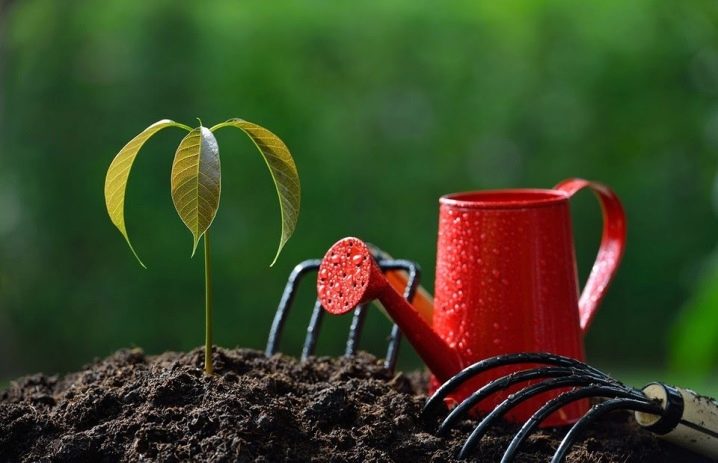
Separately, it should be said about air humidity. Mango is a tropical crop, so it is very moisture demanding.It is necessary to maintain the parameter at 70-80%. To do this, you can plant other plants nearby, place bowls of water in the room, put wet moss, put a humidifier, and more. Every two days, mango leaves are sprayed with warm water.
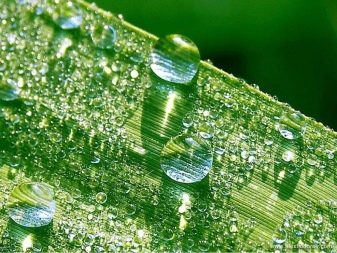
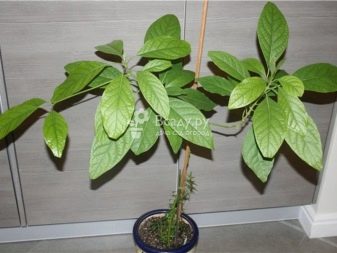
Fertilizers
Home-grown trees require feeding, but this should be limited. Excess is even more harmful than lack. In springtime, while the tree has not yet bloomed, preference should be given to mineral compositions for palm trees or tropical crops. Fertilizers for citrus plants are also suitable. They are bred in water and watered every two weeks.
When the tree has faded, it will need organic... If you do not want to use dung or mullein in your apartment (which will nevertheless be the best for the plant), then choose more neutral products, for example, an infusion of herbs, nettles, dandelions. Such feeding lasts until mid-October. In addition, a couple of times during the growing season, the mango will need to be fed on the leaf with boric acid or copper sulfate. The correct proportion is 1 gram per 1000 ml of water.
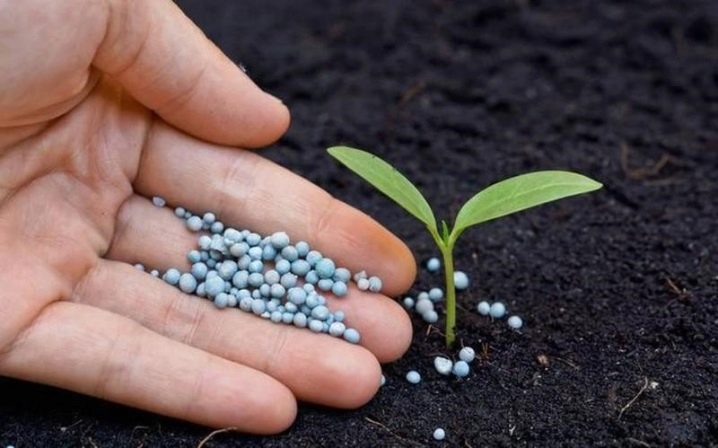
Pruning
This procedure is not carried out by everyone, but there is still a certain meaning in it, otherwise the tree will stretch up. In order not to get a real giant, you need to pinch the growth point in time. This is a meter or one and a half meters, some allow you to grow up to two meters. Pinching the growth point will start the process of growing additional branches, thanks to which the tree will acquire a beautiful and even crown.
It is imperative to cut branches that grow incorrectly, at the wrong angle. Also dry and weak. Such branches are cut to the base. If there is diseased foliage on the tree, it must also be removed. The pruning procedure is carried out in the autumn period, 21 days after the removal of the fruits from the branches.
Thinning, by the way, is only done in the first couple of years of fruiting. Then the fruits themselves will break off branches that the tree does not need.

Transfer
This is a mandatory procedure for young mangoes, they do it every year for the first 5 years, as the tree quickly "grows" out of its pot. Transplanting should be done in the spring or early summer. The capacity is taken a little more than the previous one, you cannot plant it "for growth", otherwise the roots will rot. Water the mango and wait for about 30 minutes. In the meantime, they equip the drainage and pour the substrate into a new pot. Together with the earthen clod, they remove the tree, place it in a new container, pour the earth on the sides without tamping. The top of the roots should be at ground level. After watering, the pot with the tree is placed in the shade for 7 days.
After 5 years, the mango will need to be replanted every 3 years. The rules of procedure remain the same. A pallet is required if the roots suddenly break through the bottom of the container.
You can no longer transplant large trees, therefore, during the last transplant, pick up a high-quality tub or flowerpot. Then just update the earth layer from the top layer.
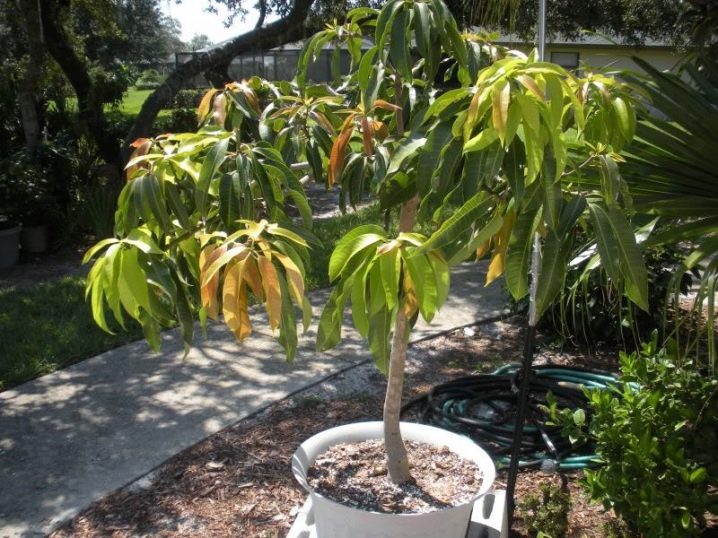
How to vaccinate?
In order for a young tree to have fruits, it must be grafted. Without this, you will not be able to wait for either flowering or harvest. It is best to vaccinate two-year-old samples, and the procedure is required in the spring. The only difficulty that may arise in this case is the need for a fruiting mango tree, because the material will be taken from it.
Basically, mangoes are grafted by budding method. It assumes several next steps.
-
Take a small knife or blade, disinfect... From the tree that bears fruit, cut off the bud, as well as a small part of the bark near it. Treat the cut with a garden pitch.
-
Make a "T" cut on your tree at the bottom, insert the resulting material there. Wrap the place with plastic wrap, but so that the kidney is visible.
-
Then, in an ordinary polyethylene bag, they make several holes and cover them with a young mango. The pot with the plant is placed in a warm place and in the light. The vaccination takes about one and a half months to take root.
-
When this time is up, you will need to cut the branch that grows above the graft.... Be sure to process the cut. After that, it remains only to wait for flowering. On average, it occurs in three years.
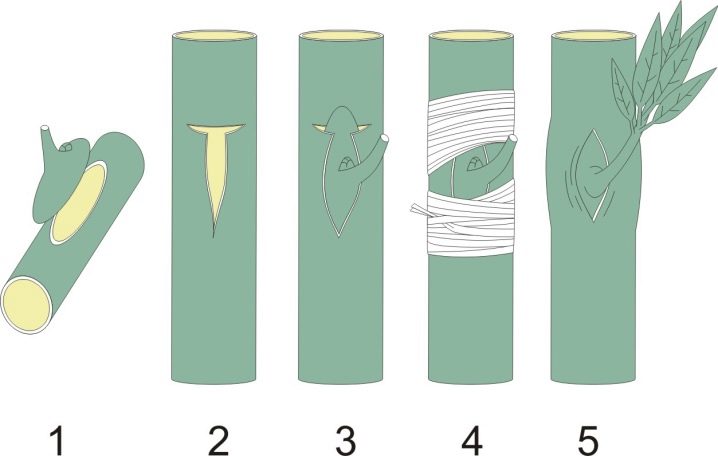
In rare cases, mangoes are grafted using a cutting. The fact is that the procedure may seem complicated to a beginner due to inexperience. Although for experienced gardeners, it does not represent anything difficult. You need to cut the stock at an angle (this is your tree), and then combine it with the scion (cutting from the fruiting one). The difficulty is that both the scion and the stock must be of the same thickness and cut at the same angle.
A cutting from a fruiting mango is cut from the top of any shoot and should be about 10 centimeters long. Copies are combined, wrapped with electrical tape. Further, they are waiting for fusion.
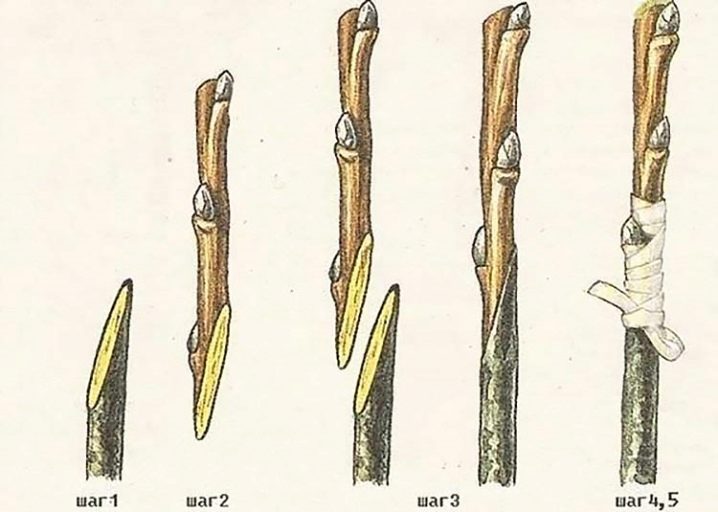
Diseases and pests
At home, mangoes are almost not affected by diseases, and this is not surprising, because usually such plants are looked after very carefully, due to the complexity of obtaining and decorative qualities. But in some situations, problems can arise.
- Anthracnose... Most often, this fungal disease affects weak plants. It is characterized by the appearance of brown spots with a light rim on the foliage. Ulcers also appear on the trunk. You can save a tree from disease by sprinkling the soil with crushed activated carbon every month. The treatment is to be done by means of "Oxyhom" or "Skor".
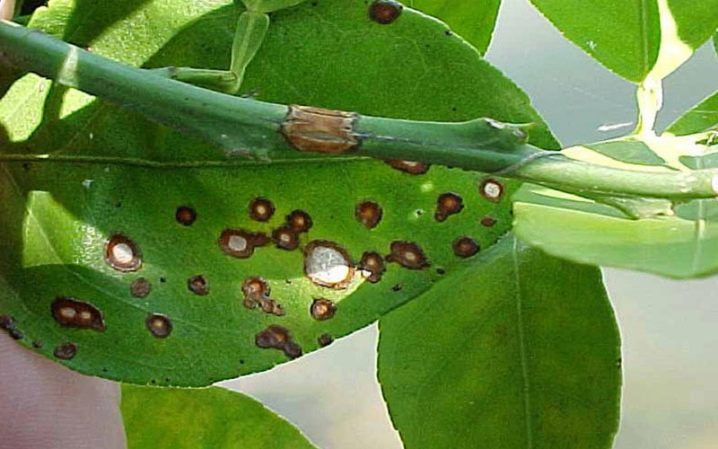
- Bacteriosis... A symptom of this disease is the darkening of the edge of the leaf plate. The leaf itself dries up, but continues to be on the tree. The preventive measure of the disease is the preliminary treatment of the seeds, which was described above. If the disease still attacked, you need to remove the diseased tissue, capturing about 5 centimeters of healthy ones.
Places of cuts are treated with a solution of copper sulfate at a concentration of 2%. Then the tree is watered for 30 days with a weak solution of manganese, and "Trichodermin" is embedded in the soil.
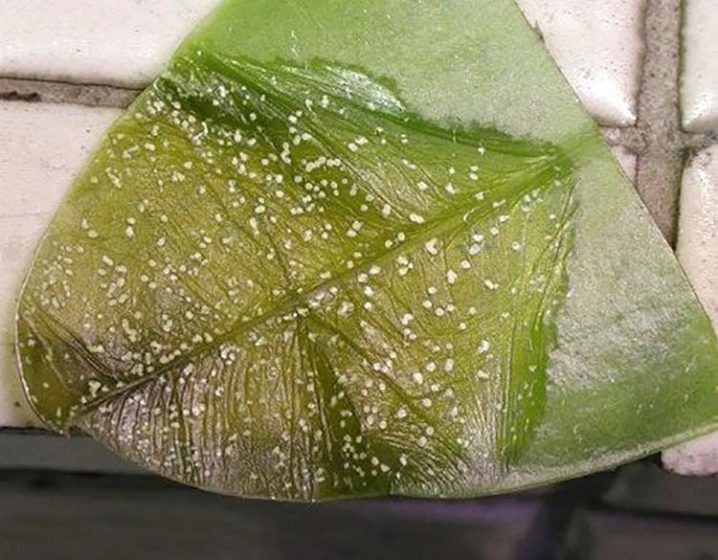
- Powdery mildew... It is immediately recognized by the white bloom on the foliage. It is necessary to treat quickly, until the disease has passed to the fruit. Periodic treatment with infusion of wood ash serves as a prophylaxis, and the disease is treated with "Topaz" or other similar fungicides.

House pests are usually less frequent, but they can easily enter through the window. For example, a tree may start spider mite... It is worth getting rid of it with the help of acaricides, with several treatments and different preparations ("Apollo", "Omite", etc.). Scabbard removed by hand, and then the tree is washed under the shower and sprayed with "Fufanon".
Aphids will scare off the pungent aroma. If there were precedents, it is worth sprinkling the mango from time to time with infusions of red pepper, garlic, lavender, wormwood. Any insecticide with a general type of effect will help from breeding pests.
As for thrips, gardeners consider Fitoverm to be the best remedy for them.
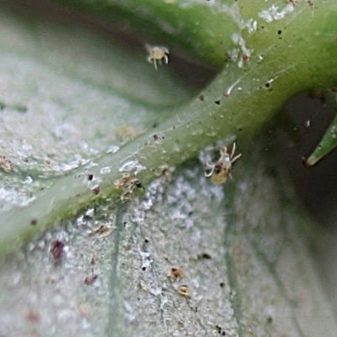
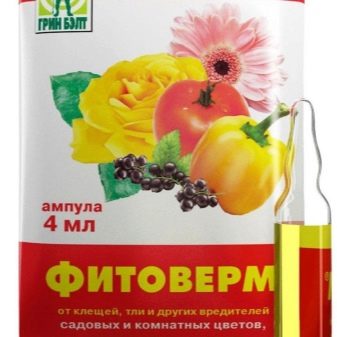













The comment was sent successfully.